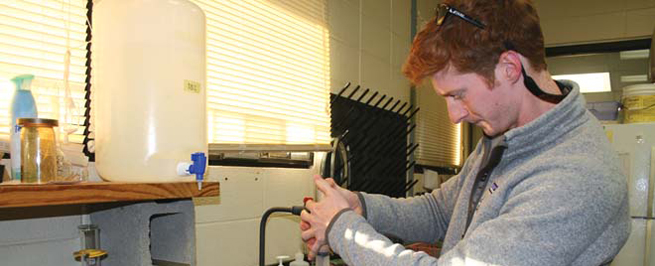
“These students are learning about water sampling, analysis and creative problem solving, which will help them find good jobs and keep our state supplied with talented engineers to address water resource needs.”
Brian Haggard, AWRC Director
By April Robertson
Morgan Welch, a graduate student studying biological engineering, stands in the middle of a bridge dangling a clear, horizontal cylinder, known as an alphasampler, by a rope, easing it into Mullins Creek to scoop up a sample from the middle of the water.After retrieving a couple of samples, Welch repeats the process at two urban creeks in Fayetteville, Niokaska Creek at Gulley Park and Spout Springs near Walker Park. Sampling from these three creeks allows him to look at how urban development changes the quality of the water.
It’s the first step in establishing better water quality: finding the root of the problem.
Typically, he takes samples during daylight hours at each site weekly to establish chemical conditions during base-flow and storm events at the stream. Upon returning to the lab, he analyzes the water for various forms of nitrogen, phosphorus and solids or sediment to evaluate the water quality at each creek.

Graduate student Morgan Welch analyzes water samples from urban creeks in Northwest Arkansas. Welch is a recipient of a scholarship from the Arkansas Academy of Mechanical Engineering.
Welch’s research will help establish how nutrients in urban streams change seasonally, how urban development affects water quality, and how loads from urban areas compare to those from agricultural areas.
Welch works for the Arkansas Water Resources Center, which collaborates with the U of A to train water scientists and engineers. Brian Haggard, director of the AWRC and a U of A engineering professor, explained that his students learn valuable skills working for the center. “These students are learning to perform water sampling, analysis and creative problem solving, which will help them find good jobs, and keep our state supplied with talented engineers to address water resource needs.”
The Illinois River Question
Jason Corral hops out of his truck, shrugs on a red jacket, straps on wading boots and heads into the White River. He steps from stone to stone, stops suddenly and plunges a large metal pole into the rushing water. He consults the electronic meter on his waist, which is collecting data by way of acoustic Doppler current meter.Corral is a biological engineering graduate student at the U of A who conducts nutrient dynamics research on the Illinois River and Lake Frances, a shallow lake on the border between Oklahoma and Arkansas. His research sampling trips often begin this way, using the acoustic Doppler current meter to track the flow rate– the discharge and velocity–of water by shooting sound waves into the water and tracking the rate at which they return. Since the rate varies so widely from point to point in rivers and streams, he will begin in one spot, take the flow rate measurement, then move up the stream to repeat the process, then downstream to repeat the process once more. Back at the lab, he’ll calculate the average of the three numbers to record an accurate daily measurement.
Next, he scoops up a sample or two of the water with a plastic bottle. Later, he’ll analyze it for levels of phosphorus, nitrate and other nutrients.
Two States, Two Sets of Regulations
The Illinois River is important because the regulations on clean water differ between the two states. “Oklahoma considers it a scenic waterway and Arkansas considers it to be on the level just under that,” Corral said. This means that limits on the amount of phosphorus allowed in the water are lower on the Oklahoma side.
Arkansas researchers like Corral have been monitoring water quality on their state side, showing steady improvements. The problem is that by the time the water from the Illinois River makes it to Oklahoma, the water chemistry may change, increasing in nutrients, like phosphorus and nitrogen, that are a potential problem for the aquatic health of the river. These nutrients facilitate the development of algae, which limits the amount of oxygen and impacts the fish and other animals that live in the water.
Corral gathers samples of water from the Illinois River above and below Lake Frances to establish whether it is contributing to a decline in water quality. His research will also focus on sediments in the small lake, which are an important source of nutrients.
Phosphorus loading leads to the degradation of water quality and of the ecosystem, so Corral’s goal is to establish where it happens. A lot of times, phosphorus is tied up in sediment, so before leaving, he takes a sediment core. “Lake Francis has stored a lot of sediment,” said Haggard. “We suspect that these sediments are transferring phosphorus and maybe nitrogen to Oklahoma, releasing them back into the water.”
To take a core, Corral plunges a device made largely of PVC pipe into the water and waits for the weight on top to do its work, sending it straight to the floor for a bit of sediment with a layer of water on top. He will incubate these cores in the lab and measure the amount of phosphorus and nitrogen released from the sediment into the overlying water over time.
Moving Toward a Solution
In the past, levels of phosphorous were often evaluated because of their link to poultry farms and agriculture, where interactions between fertilizer and soil caused phosphorus to accumulate at the soil surface. Over the last decades, phosphorus concentrations have been linked to urban development and wastewater treatment plants. It’s important to understand where phosphorus and other pollutants come from, because it allows researchers to come up with solutions.
If the results of Haggard and Corral’s research suggest that Lake Francis is responsible for increased phosphorus in the Illinois River, a possible solution would be to induce sediment treatment or dredging. Sediment treatment is a process that uses chemicals to bind the undesirable nutrients, while dredging removes the nutrients altogether.
The fluctuation in the water quality of the Illinois River between the states of Arkansas and Oklahoma has been an important issue, and the long-term data shows that phosphorus is decreasing in the Illinois River – a success story.


